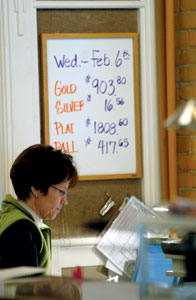As gold prices have soared and the economy has soured, some area pawnshops and gold retailers have seen a steady uptick in customers, some looking to buy, most hoping to cash in – even on their dental work.
Necklaces, coins, rings and, yes, even gold fillings, along with anything else containing the precious metal, have become a hot commodity in recent months.
In January, gold hit record territory – not accounting for inflation – of about $930 an ounce before dropping down to fluctuate on either side of $900 last week. Investors expect prices to rise even further in 2008 and possibly peak at over $1,000 an ounce.
Silver has crept up in value, too, flirting with the $17-an-ounce level, nearly quadruple its price just seven years ago. Those record prices have meant record business for gold dealers like Coins and Carats in downtown Kalispell.
“This was our busiest January,” owner J.B. Love said of his 18 years running the store. “We’ve seen three times the volume as prices have risen.”
Most of that increase has come in the form of new customers, looking to take advantage of bullish prices. Rather than having one person a week who’s new to gold dealing, Love said it’s not uncommon for him to see three to 10 greenhorns a day.
 |
|
Marilyn Ethington works near a board with the day’s posted values of gold, silver, platinum and palladium at Coins and Carats in Kalispell. Each morning the new values are written up on the board. |
Those looking to sell aren’t always the stereotypical down-on-the-luck customers looking to make a quick buck, Love said. Many are middle- to upper-class people who prefer to keep part of their portfolio in physical gold. “It’s like the stock market, only you’re dealing with a physical product,” he said.
Kalispell commodities broker Peter Luce said gold often moves in the opposite direction of the dollar, and strengthening gold prices are seen, in part, as a reflection of the public’s concerns about inflation. With rumblings about a possible recession, drops in the stock market, and mortgage troubles, investors look at gold as a safe place to park their money.
“The big thing is that historically gold has always been a place to go to be safe,” Luce said. “People who are real uncomfortable with what’s going on with the country and the economy right now view gold as a good hedge against inflation.”
In Missoula, David Hakes, owner of Missoula Gold and Silver Exchange, said around 50 customers a day have walked in carrying everything from broken wedding bands to teeth in hopes of selling. But, he’s also seen nearly as many customers looking to buy.
“We’re almost balanced out,” he said. “I’m flabbergasted, because normally these levels would be sell only. People coming in are afraid of what’s going on with the economy, the dollar and the sub-prime mortgages. It gives them peace of mind to invest in a physical product.”
Just like Coin and Carats, the combination of those looking to buy and sell has also meant record numbers for Hakes’ business. “It’s two to three times what we normally see,” he said. “It’s tremendous. The most we’ve seen since 1980.”
The price of gold hit a record in 1980 at $875 per ounce – around $2,000 in today’s dollars – followed by a drop to around $300 two years later. It remained below $500 until about two years ago, when it began a sustained climb. Prices rose steadily in 2007, beginning at $625 in January and nearing $900 at the end of the year.
But before people rush out to jump in on the boom, brokers and dealers caution that while gold is generally seen as a safe investment, that doesn’t mean it’s totally predictable. “It’s still speculation,” Luce said. “If we knew exactly where gold was going, I’d buy a lot of it and be done working.”
Love and Hakes both stop short of predicting how high the current boom will go, saying instead that the market still looks like it’s rising and hasn’t shown much of a slow down.
“Nothing goes up forever though,” Love added.